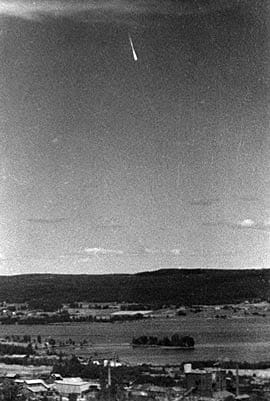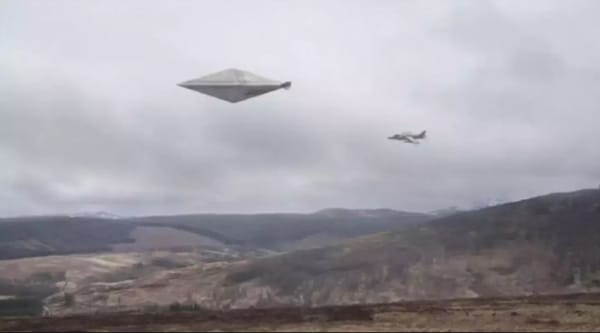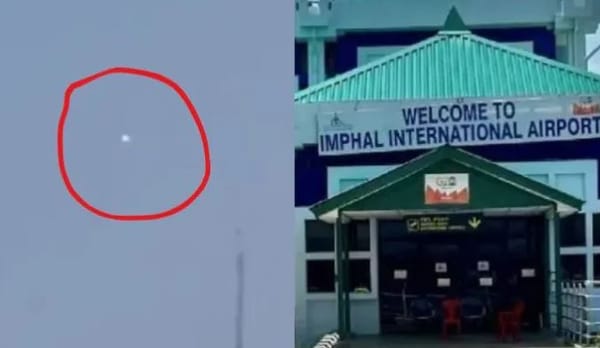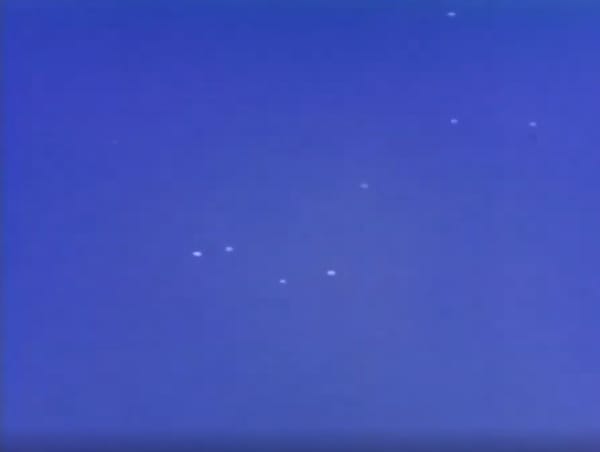The 1946 Scandinavian Ghost Rockets

In 1946, a series of unidentified flying objects resembling rockets or missiles were observed primarily in Sweden and nearby countries. Known as "ghost rockets," these sightings began on February 26 and continued throughout the year, peaking in August. Approximately 2,000 reports were logged, with about 200 verified by radar and some involving physical fragments.
The origin of these objects has been debated, with theories ranging from Soviet military tests to natural phenomena. The Swedish military investigated these sightings, while international interest also emerged, including from the U.S. and Greek authorities. This article examines the initial descriptions, investigations, and international responses to the ghost rockets.
The Incidents
The phenomenon of "ghost rockets" first emerged in 1946, beginning with reports from Finland on February 26. Over the course of that year, a significant number of sightings were recorded, with about 2,000 reported incidents by December. These sightings were characterized by objects resembling rockets or missiles, and were observed primarily in Sweden, though neighboring countries like Finland and Norway also reported similar phenomena.
The sightings often described fast-moving, rocket-shaped objects, sometimes with wings. In some cases, observers reported slower-moving, cigar-shaped objects. The objects were visible for only brief periods, ranging from a few seconds to a minute. Occasionally, witnesses reported hearing a hissing or rumbling sound associated with these objects.
Crashes involving these objects were not uncommon. Many of the reported crashes occurred in lakes, with objects sometimes seen skimming across the water before sinking. Notably, on July 19, 1946, a gray, rocket-shaped object was reported to have crashed into Lake Kölmjärv in Sweden. Despite a thorough search by the Swedish military, which lasted for three weeks, no physical evidence of the object was recovered. The military reported disturbances on the lake's bottom but found no conclusive remains.
The Swedish military, including officers like Karl-Gösta Bartoll, conducted several investigations into these sightings. Bartoll’s report indicated that the object observed in Lake Kölmjärv might have disintegrated due to being made of lightweight material, such as magnesium alloy. This explanation suggested that the lack of physical evidence could be attributed to the object's destruction during its descent. Bartoll later reiterated his belief that the sightings involved real, physical objects.
In October 1946, the Swedish Defense Staff publicly expressed skepticism regarding the ghost rockets, stating that many observations were vague and unsubstantiated. However, they acknowledged that some reports could not be easily explained as natural phenomena or misidentified aircraft. The investigations included attempts to recover debris, but most of the fragments found were dismissed as ordinary materials, such as coke or slag.
The U.S. military also took interest in the ghost rockets, with notable figures like General Jimmy Doolittle and General David Sarnoff visiting Sweden to review the reports. Despite extensive investigations, no definitive conclusion was reached about the origin of the ghost rockets.
U.S. Involvement
By early August 1946, the U.S. military began to show significant interest in the ghost rocket sightings. Swedish Lt. Lennart Neckman reported seeing what he was certain was a rocket projectile. This spurred further interest from U.S. officials, including Undersecretary of State Dean Acheson and U.S. Army Air Forces intelligence.
On August 14, 1946, the New York Times reported that Acheson was particularly interested in the sightings. The situation escalated when General Jimmy Doolittle and General David Sarnoff, notable figures in aviation and military intelligence, arrived in Stockholm around August 20, ostensibly for unrelated business. The official explanations for their visits were linked to their roles in the private sector and the radio equipment market, but their presence was also interpreted as a response to the ghost rocket phenomenon. Both generals were briefed on the sightings, and Sarnoff expressed his belief that the phenomena were real missiles rather than myths.
On August 22, 1946, Lt. Gen. Hoyt Vandenberg, the director of the Central Intelligence Group (CIG), issued a Top Secret memo to President Truman. This memo suggested that the ghost rockets could have originated from the German V-1 or V-2 rockets, possibly launched from the Peenemünde site, and speculated that these could be extended-range tests intended for the Gulf of Bothnia. The memo also mentioned that the missiles might have been designed to self-destruct with small demolition charges or burn out, which would explain the lack of substantial debris.
Despite these theories, investigations did not confirm launches from Peenemünde or other known German rocket sites after February 1945. The lack of clear evidence made it difficult to ascertain the true origin of the objects.
Swedish Military Opinion
As the investigations continued, the Swedish military's stance on the ghost rockets remained cautious. A Top Secret document from the United States Air Force Europe (USAFE) dated November 4, 1948, revealed that some investigators entertained the idea that the ghost rockets, along with later sightings of "flying saucers," might have extraterrestrial origins. This document, declassified in 1997, reflected a broader uncertainty and the acknowledgment that the technology behind these objects might surpass known capabilities. The document suggested that the objects could originate from an unknown or unidentified technology, possibly outside Earth. This theory was kept under consideration while officials maintained an open mind regarding the potential explanations.
Aftermath
The aftermath of the ghost rocket sightings was marked by ongoing debate and a range of investigations, but the ultimate conclusions remained inconclusive.
In the immediate wake of the sightings, Swedish authorities and military personnel continued to investigate the reports and recover any potential debris. Despite extensive searches and evaluations, the evidence collected—such as fragments claimed to be from the ghost rockets—was often found to be ordinary materials, such as coke or slag, rather than conclusive rocket remnants.
In December 1946, a report from the Swedish Defense Staff acknowledged that while many of the reported impacts could be attributed to real physical objects observed during daylight, the nature of these objects remained unclear. The debris collected was later identified by some sources as meteorite fragments, which contributed to the prevailing theory that many of the sightings were caused by meteor activity.
In the United States, interest in the ghost rockets did not wane quickly. The initial theories suggesting a Soviet origin, particularly regarding long-range missile tests from Peenemünde, did not find substantial backing. The U.S. military's secret documents, including the memo from Lt. Gen. Hoyt Vandenberg, indicated a range of possible explanations, including the idea of extraterrestrial origins. However, these theories did not gain widespread acceptance and were not substantiated by concrete evidence.
The Swedish military's official stance remained skeptical but open to various possibilities. By 1948, the Swedish Defense Staff and other authorities had largely moved on from the intense scrutiny of the ghost rockets, focusing on other pressing issues of the post-war period. The investigations led to a mix of scientific, military, and speculative interpretations, but no definitive answers emerged.
Public interest in the ghost rockets faded over time, and the sightings became a topic of historical curiosity rather than immediate concern. The incident remains a subject of interest for UFO researchers and historians who study unexplained aerial phenomena from the mid-20th century, reflecting the broader intrigue and uncertainty surrounding unidentified flying objects during the early years of the Cold War.
Conclusion
The ghost rocket sightings of 1946 remain a fascinating and unresolved chapter in the history of unidentified aerial phenomena. Despite extensive investigations by Swedish, U.S., and other military and scientific bodies, conclusive evidence about the nature of these objects remains elusive. While many sightings were attributed to meteor activity and other natural explanations, the persistent reports and recovered debris have continued to fuel speculation. The incident reflects the broader post-war anxieties and the challenges of distinguishing between natural phenomena, experimental technologies, and other unknowns during the early Cold War era.



